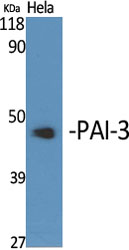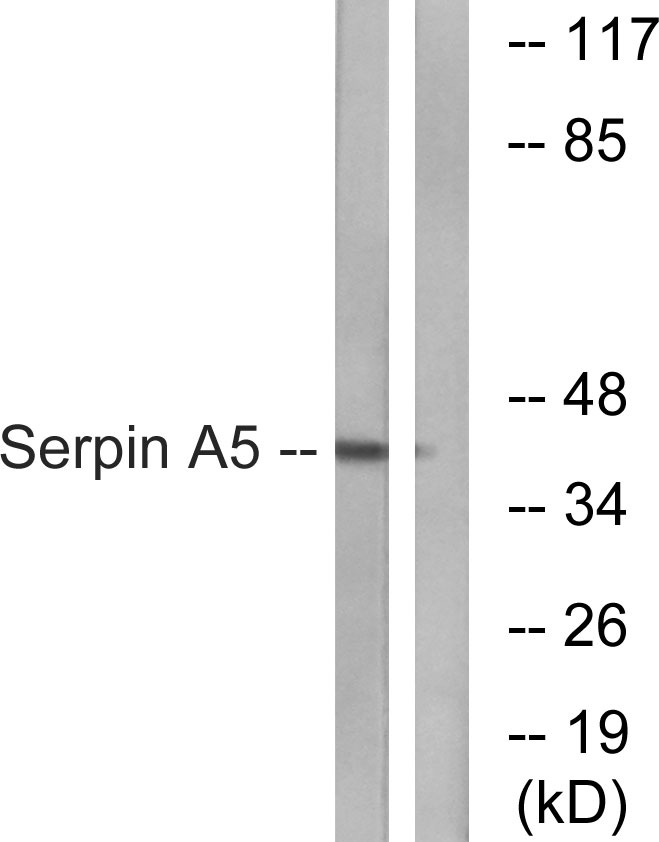PAI-3 Polyclonal Antibody
- Catalog No.:YT3571
- Applications:WB;IHC;IF;ELISA
- Reactivity:Human;Mouse
- Target:
- PAI-3
- Fields:
- >>Complement and coagulation cascades
- Gene Name:
- SERPINA5
- Protein Name:
- Plasma serine protease inhibitor
- Human Gene Id:
- 155698
- Human Swiss Prot No:
- P05154
- Mouse Swiss Prot No:
- P70458
- Immunogen:
- The antiserum was produced against synthesized peptide derived from human Serpin A5. AA range:260-309
- Specificity:
- PAI-3 Polyclonal Antibody detects endogenous levels of PAI-3 protein.
- Formulation:
- Liquid in PBS containing 50% glycerol, 0.5% BSA and 0.02% sodium azide.
- Source:
- Polyclonal, Rabbit,IgG
- Dilution:
- WB 1:500 - 1:2000. IHC 1:100 - 1:300. ELISA: 1:20000.. IF 1:50-200
- Purification:
- The antibody was affinity-purified from rabbit antiserum by affinity-chromatography using epitope-specific immunogen.
- Concentration:
- 1 mg/ml
- Storage Stability:
- -15°C to -25°C/1 year(Do not lower than -25°C)
- Other Name:
- SERPINA5;PCI;PLANH3;Plasma serine protease inhibitor;Acrosomal serine protease inhibitor;Plasminogen activator inhibitor 3;PAI-3;PAI3;Protein C inhibitor;PCI;Serpin A5
- Observed Band(KD):
- 42kD
- Background:
- The protein encoded by this gene is a member of the serpin family of proteins, a group of proteins that inhibit serine proteases. This gene is one in a cluster of serpin genes located on the q arm of chromosome 14. This family member is a glycoprotein that can inhibit several serine proteases, including protein C and various plasminogen activators and kallikreins, and it thus plays diverse roles in hemostasis and thrombosis in multiple organs. [provided by RefSeq, Aug 2012],
- Function:
- function:Inhibits activated protein C as well as plasminogen activators.,similarity:Belongs to the serpin family.,tissue specificity:Expressed by the liver and secreted in plasma.,
- Subcellular Location:
- Secreted, extracellular space . Localized on the plasma membrane overlying the acrosomal head of spermatozoa of ependymal spermatozoa and ejaculated sperm. Localized at the equatorial segment of acrosome-reacted spematozoa. Localized in alpha granules in resting platelets and on the external plasma membrane and within the surface-connected cannalicular system in activated platelets.
- Expression:
- Predominantly expressed in the epithelium of seminal vesicles. Expressed in the proximal tubular epithelium of the kidney. Expressed in the superficial and more differentiated epidermal keratinocytes of the skin. Expressed in megakaryocytes and platelets. Expressed poorly in kidney tumor cells compared to non tumor kidney tissues. Expressed in spermatozoa. Present in very high concentration in seminal plasma. Present in high concentration in plasma, synovial and Graaf follicle fluids. Present in low concentration in breast milk and in amniotic fluids. Present in very low concentration in urine, cerebrospinal fluids, saliva and tears (at protein level). Strongly expressed in liver. Expressed in kidney, spleen, pancreas, skeletal muscle, heart, testes, ovary, interstitial Leydig cells, epidi
- June 19-2018
- WESTERN IMMUNOBLOTTING PROTOCOL
- June 19-2018
- IMMUNOHISTOCHEMISTRY-PARAFFIN PROTOCOL
- June 19-2018
- IMMUNOFLUORESCENCE PROTOCOL
- September 08-2020
- FLOW-CYTOMEYRT-PROTOCOL
- May 20-2022
- Cell-Based ELISA│解您多样本WB检测之困扰
- July 13-2018
- CELL-BASED-ELISA-PROTOCOL-FOR-ACETYL-PROTEIN
- July 13-2018
- CELL-BASED-ELISA-PROTOCOL-FOR-PHOSPHO-PROTEIN
- July 13-2018
- Antibody-FAQs
- Products Images

- Western Blot analysis of various cells using PAI-3 Polyclonal Antibody
.jpg)
- Western Blot analysis of Hela cells using PAI-3 Polyclonal Antibody

- Western blot analysis of lysates from Jurkat cells, using Serpin A5 Antibody. The lane on the right is blocked with the synthesized peptide.



